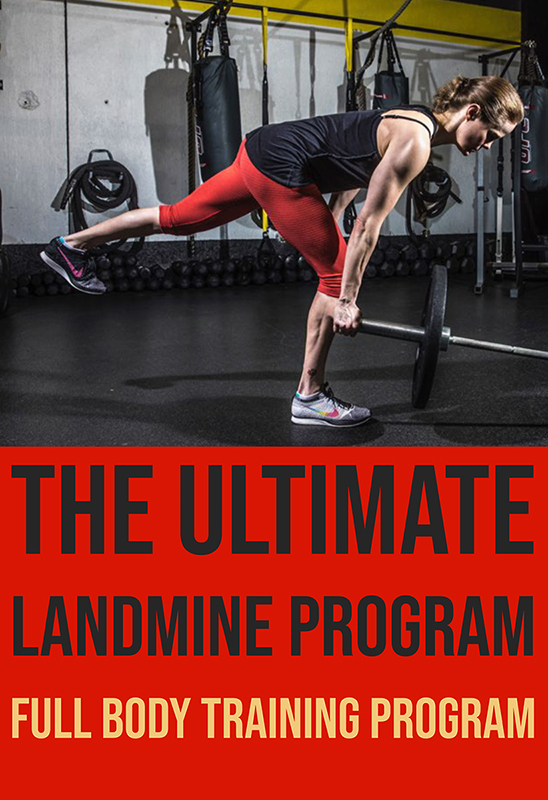Today marks the release of Meghan Callaway’s latest resource, The Ultimate Landmine Program,
I thoroughly enjoyed her previous resource, The Ultimate Pull-Up Program, and used it with several of my own clients with great success.
I envy Meghan’s brain. She thinks of stuff I never would have thought of, and this latest program of her’s exploits that to the umpteenth degree.
Check it out HERE (it’s on SALE this week only), and also check out her article below showcasing some not-so-common core exercises utilizing the Landmine.

3 Landmine Core Exercises You May Have Not Seen Before
Landmine training and the countless exercises you can perform are badass, empowering, and extremely beneficial, and can be a key component in your training program. I am a huge fan of landmine training, and have been for a long time.
To be clear, while using a landmine attachment is great, it is not mandatory.
You can rest the barbell against a secure surface like a wall, box/other object, or on a no-slip surface. So really, all that is required to perform landmine exercises is a barbell and perhaps several weight plates.
Here are three landmine core exercises you might not have seen or tried before.
While these landmine exercises absolutely involve the upper body as well, and provide many benefits, these unique variations especially work wonders for improving lumbo-pelvic stability.
#1) Landmine Tall Kneeling Presses + Band Resistance
This exercise strengthens the chest, shoulders, and triceps, improves shoulder and scapular controlled mobility, and lumbo-pelvic stability. This exercise (and many other landmine pressing exercises) can be a great option if you struggle to perform overhead pressing movements.
Coaching Tips:
- Set up a barbell so it is lengthwise, and is in line with the center of your body. You may anchor the barbell against a stable surface like a wall, weight plate, or box, or on a no slip surface. You may also use a Landmine attachment.
- Loop a resistance band over the top of the barbell, and rest the band underneath your knees. There should be tension in the band for 100% of the movement.
- Grab onto the top portion of the barbell. As for your grip, I like to interlock my fingers and place my hands on top of each other as this makes the body more symmetrical.
- Get into a tall kneeling stance. Place your knees so they are approximately hip to shoulder width apart, and have a very slight forward lean in your torso. Your head, torso and hips should be in a stacked position.
- Before each rep, take a deep breath in (360 degrees of air around your spine), brace your core (360 degree brace around your spine), tuck your ribs towards your hips (close the space in your midsection), and squeeze your glutes.
- Now extend your elbows and press the barbell to a range where you are able to maintain proper form, then “row” the barbell back in to your body. In fact, your ability to control the movement of your shoulder blades plays a big role in your ability to perform this exercise. Do not keep your shoulder blades pinned. They are meant to move.
- As you bring the barbell back in towards your body, stop just before your elbows touch your sides.
- For the duration of the exercise, your head, torso and hips should remain in a stacked position. Do not allow your lower back to hyperextend, ribcage to flare, or your torso, spine or hips to rotate.
- Exhale after you have initiated the press and as the barbell is traveling away from your body. Inhale and reset as the barbell is returning towards your body, or pause in the starting position, and inhale/reset there before the next rep. Do what works and feels best for you.
Regression:
Make this exercise easier by using less weight, or by using a band with less resistance.
Progression:
Make this exercise more challenging by using more weight, by using a band with more resistance, or by performing negative reps and taking 3-5 seconds to “row” the barbell back down to the starting position.
#2) Contralateral Bird Dog Hold + Landmine Single Arm Rows
This deceptively challenging exercise strengthens the mid and upper back, improves grip strength, shoulder and scapular controlled mobility (and stability on the planted side), and lumbo-pelvic stability.
This exercise requires a significant amount of lumbo-pelvic stability and is arguably more of a core exercise than an upper body movement. Be conservative when you are selecting your weight, and opt for 25-50% of what you’d use to perform single arm rows.
If you are performing this exercise correctly, aside from the arm that is performing the rowing movement, the rest of your body should remain in a fixed position.
Coaching Tips:
- Set up a barbell so it is lengthwise, and is behind your body. You may anchor the barbell against a stable surface like a wall, weight plate, or box, or on a no slip surface. You may also use a Landmine attachment.
- Kneel with one leg on a bench, and place the hand that is on the opposite side of your body on the bench. Make sure that your shoulder is directly above your hand. Spread your fingers, and pretend you are suctioning your hand to the bench.
- Extend your leg that is on the opposite side of your body as the rowing arm, and so it is parallel to the ground.
- Set your body so it is in a straight line from your head to heel, and maintain this position for the duration of the exercise. Make sure that your torso and hips are square to the bench. Also, do not allow your leg to drop, or conversely, lift too high (avoid hyperextending your lower back).
- Before each rep, take a deep breath in (360 degrees of air around your spine), brace your core (360 degree brace around your spine), tuck your ribs towards your hips (close the space in your midsection), and squeeze your glutes.
- Initiate the movement by using the muscles in your mid and upper back and draw your shoulder blade in towards the spine (retract). Do not initiate the movement with your arm, and do not use excessive momentum.
- In the top position, do not allow your elbow to flare out; instead keep it close to your side.
- Lower the barbell with control, and make sure you keep your shoulder from collapsing. During the lowering/eccentric component, do not keep your shoulder blade pinned. It is meant to move, and should perform the reverse movement (protraction) as it did during the rowing/concentric component.
- Pay attention to your non-working/supporting side. Push away from the bench and protract your shoulder blade (move it away from the spine). Do not mindlessly hang out.
- For the duration of the exercise, your head, torso and hips should remain in a stacked position. Do not allow your lower back to hyperextend or round, ribcage to flare, or your torso, spine or hips to rotate. Your torso and hips should remain square to the bench.
- Exhale right after you have initiated the rowing movement; you may inhale/”reset” as the barbell is returning to the starting position, or hold your breath for the duration of the rep, exhaling, inhaling, and re-setting between reps. Do what works and feels best for you.
Regression:
Make this exercise easier by using less weight.
Progression:
Make this exercise more challenging by using more weight.
#3) Dead Bug + Single Arm Landmine Presses (Weight Behind)
I am a huge fan of dead bugs, and use many different variations in my training, and in the programs of the many people I work with. This innovative dead bug variation improves lumbo-pelvic stability, and shoulder and scapular controlled mobility.
Coaching Tips:
- Set up a barbell so it is lengthwise and behind you, and is in line with your armpit. You may anchor the barbell against a stable surface like a wall, weight plate, or box, or on a no slip surface. You may also use a Landmine attachment.
- Lie on the floor. Lift up your legs so they are in a vertical position, straighten your knees, and point your feet towards you (dorsiflex). If you cannot fully extend your knees, or if you are unable to maintain proper form, you can keep your knees bent at a 90 degree angle. Make sure they remain at a 90 degree angle for the duration of the exercise.
- Keep your chin tucked and neck in a neutral position, extend your arms so they are above your chest, and tuck your ribs towards your hips (close the space in your midsection).
- Pay attention that you are not “cheating” by using the muscles in your neck and/or upper body in place of the muscles of the anterior core.
- Before each rep, take a deep breath in (360 degrees of air around your spine). Now steadily exhale through your mouth, contract your anterior core muscles as hard as you can, slowly “row” the barbell down towards the floor and simultaneously lower the leg that is on the same side of the body, and to a range where you are able to maintain proper form. Once you reach your full range, simultaneously press the barbell up and return your leg to the starting position.
- You have the option of keeping the non-working arm in a vertical line over the armpit, or you can reach back with your arm as you lower the weight and your leg.
- As for the shoulder blade of the side that is performing the pressing movement, do not keep it pinned. It is supposed to move.
- For the duration of the exercise, do not allow your lower back to hyperextend, ribcage to flare, torso, spine or hips to rotate, or your hips to leave the floor.
- Keep your legs relaxed so they do not dominate.
- Make sure that your knee remains in a fixed position and that the movement occurs from your hip.
Regression:
Make this exercise easier by using less weight, by decreasing the range of the leg lowering, or by bending your knees to 90 degrees.
Progression:
Make this exercise more challenging by using more weight, by increasing the range of the leg lowering, or by adding in band or kettlebell resistance (on the hand that is not holding the barbell).
Ultimate Landmine Program
The Landmine has grown to be one of the most versatile pieces of equipment on the gym floor. You can train the entire body and if you’re someone pressed for time, prefers a more minimalist approach to training, or just likes trying new stuff, this resource will be a great fit.

It’s on sale TODAY (6/25) for $67 through Friday, June 29th so you only have a few days to take advantage. If you’re already familiar with Meghan’s work you know this is a no-brainer. If you’re unfamiliar with her work, trust me: you won’t be disappointed.



